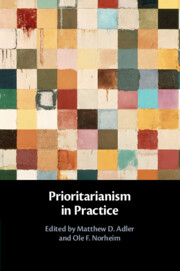Book contents
- Prioritarianism in Practice
- Prioritarianism in Practice
- Copyright page
- Contents
- Figures
- Tables
- List of Contributors
- 1 Introduction
- 2 Theory of Prioritarianism
- 3 Well-Being Measurement
- 4 Prioritarianism and Optimal Taxation
- 5 Prioritarianism and Measuring Social Progress
- 6 Prioritarianism and Health Policy
- 7 Prioritarianism and Fatality Risk Regulation
- 8 Prioritarianism and Climate Change
- 9 Prioritarianism and Education
- 10 Empirical Research on Ethical Preferences: How Popular is Prioritarianism?
- 11 Prioritarianism and Equality of Opportunity
- 12 Prioritarianism and the COVID-19 Pandemic
- Index
- References
7 - Prioritarianism and Fatality Risk Regulation
Published online by Cambridge University Press: 09 June 2022
- Prioritarianism in Practice
- Prioritarianism in Practice
- Copyright page
- Contents
- Figures
- Tables
- List of Contributors
- 1 Introduction
- 2 Theory of Prioritarianism
- 3 Well-Being Measurement
- 4 Prioritarianism and Optimal Taxation
- 5 Prioritarianism and Measuring Social Progress
- 6 Prioritarianism and Health Policy
- 7 Prioritarianism and Fatality Risk Regulation
- 8 Prioritarianism and Climate Change
- 9 Prioritarianism and Education
- 10 Empirical Research on Ethical Preferences: How Popular is Prioritarianism?
- 11 Prioritarianism and Equality of Opportunity
- 12 Prioritarianism and the COVID-19 Pandemic
- Index
- References
Summary
Environmental, transportation, occupational, and other regulations that reduce fatality risk are frequently evaluated using benefit-cost analysis (BCA). We examine how risk reductions are valued under BCA, utilitarian and prioritarian SWFs. The social value of risk reduction (SVRR) to an individual is the rate of increase of social welfare for a small decrease to the individual’s current-period fatality risk. Under BCA, the SVRR is the individual’s value per statistical life (VSL), which is increasing in wealth and baseline risk. Under utilitarian and prioritarian SWFs, the SVRR is far less sensitive to income; it can decrease with income for prioritarian SWFs that exhibit sufficient inequality aversion. The SVRR increases with or is independent of baseline risk. Like VSL, it can increase or decrease with age, but prioritarian SWFs assign larger SVRR to younger relative to older individuals than does the utilitarian SWF. Extensions to catastrophe aversion and nonfatal health risks are discussed.
Keywords
- Type
- Chapter
- Information
- Prioritarianism in Practice , pp. 317 - 359Publisher: Cambridge University PressPrint publication year: 2022
References
- 2
- Cited by



